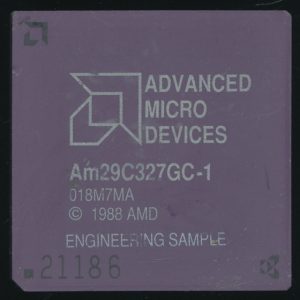AMD Am29C327: How to Take a Picture of a Black Hole
Recently I came across one of the more unusual members of the AMD Am29300 series. These were a set of processor elements (multipliers, FPUs, ALUS, registers) AMD designed to support AM29000 CPUs as well as for the bases for custom CPU designs. Some. like the AM29C323 multiplier found common use in video game and other applications. Others like the AM29C325 32-bit FPU were used in educational experiments and research. The 29300 (Bipolar) and 29C300 (CMOS) series are not particularly well known due to their obscure and often deeply specialized used. At the top of the series lies the AMD AM29C327 Double precision (64-bit) FPU. This FPU has a few tricks up its sleeves and is about as obscure in use as it gets….
The Am29C327 was on of the first chips made on AMDs CS-11A 1.2u processor (an enhancement of the 1.6u CS-11) . It was first announced in 1987 with sampling to begin in late 1988. The ‘327 contained over 250,000 transistors and was packed in a 169PGA package. It is a IEEE754 compliant double precision FPU but also supports IBM and DEC formats. It has 3 32-bit buses (2 for input and one for output) that, when multiplexed, allow for 64-bit maths. Its little brother, the ‘325, only supports 32-bit math, and comes in a 145PGA package with around 30,000 transistors (11,000 gates). So why does going to double precision involve nearly 10 times the transistor count? It turns out that the ‘327 is more closely related to an actual CPU then a normal FPU. The ‘325 has all of 8 instructions (add/sub, mult const subtraction and some conversions), while the ‘327 supports 58 instructions. Of those 58 instructions 35 are Floating point, 1 is system management, and the other 22? Those are a full set of integer instructions. The ‘327 actually supports more then just floating point. Its internal ALU is a 64-bit 3 input design, allowing inputs from either the 2 external inputs, the output, a set of 8 64-bit registers, or a set of 6 constants. Its instructions are 14 bits and it supports pipelining for even faster calculations. Interestingly, pipelining can be disabled and the FPU will work in straight flow through mode. So where is such a complicated chip used? Doing complicated math of course.
Posted in:
CPU of the Day


